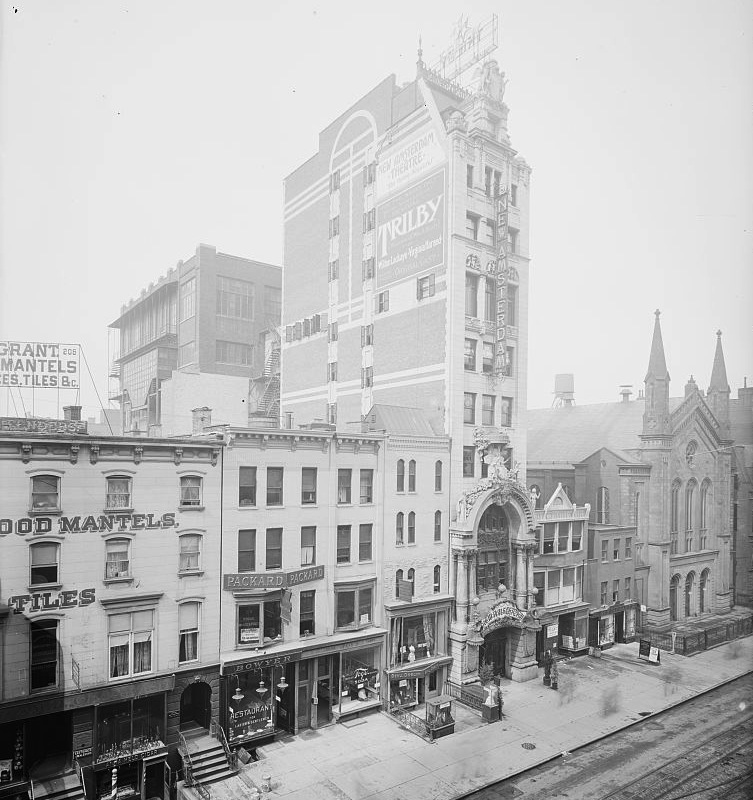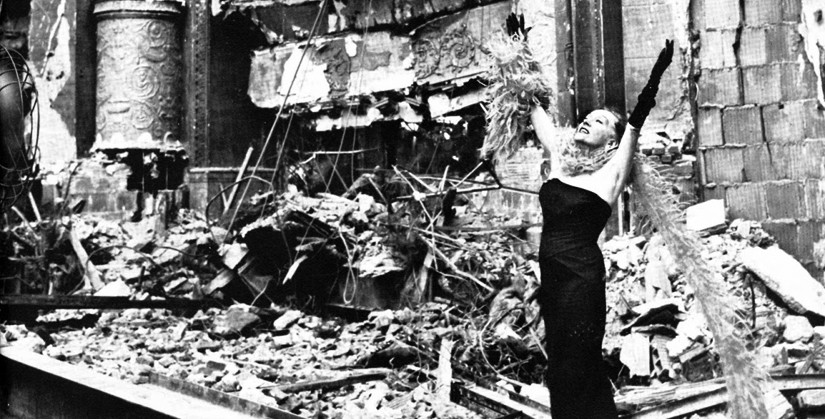
Theater District
Also known as the Theatre District, the Theater Subdistrict, or Broadway
Although some met the wrecking ball, a majority of the iconic theaters of the Theater District were preserved through concerted efforts in the 1980s.
The Broadway Theater District originated in the early 1900s as theaters began to move from Union Square and Madison Square Garden further uptown to the Times Square area because of its cheaper real estate. Two of the earliest Broadway theaters, the New Amsterdam and the Lyceum, were built in 1903. The Lyceum Theater was designed in a Beaux-Arts style by Herts and Tallant.1 Herts and Tallant also designed the New Amsterdam Theatre but in an Art Nouveau style.2
The invention of the electric light bulb paved the way for the famous electric signage, which characterizes Times Square. The first electric billboard for the play, The Red Mill, was illuminated in 1903.3 Other theaters followed this trend, and soon all of Broadway was illuminated with electric signage and referred to as “The Great White Way.”4 In 1927, the neon light was invented, bringing in a flush of new vibrant colored lights for billboards in Times Square.
The 1920s brought a tremendous spike in theater production with over 30 available venues. The Shuberts, theater owners, exclusively commissioned Herbert Krapp to design the theaters, some of which have been very successful: “Of the forty theaters built in the immediate Times Square area, Krapp’s playhouses have proven to be the most enduring.”5 The years 1927 and 1928 signaled the height of theater popularity in Times Square with 70 theaters and 250 shows, but the area faced hard times after the stock market crash of 1929 and the popularization of “talkies,” and ticket sales plunged, causing theater owners like the Shuberts to file for bankruptcy.6 The Great Depression deeply affected the area causing many theaters to shut down. Some reopened as movie theaters while others showcased live burlesque shows.
The theater district continued to face financial issues, and plunged into its worst period during the 1970s. The theaters began showing art films and pornography, which attracted prostitutes, drug dealers, and crime. The once-sparkling exteriors of the grand theaters faced dereliction and dilapidation.7 In the 1980s, the City became motivated to clean up the area by forming the New 42nd Street Development Project.8 This project combined private and public organizations, who worked to revitalize the area by renovating historic structures, introducing commercial retail in vacant buildings, and cleaning up the area. It was successful at achieving a balance of historic preservation and economic development.
In 1992, Robert A. M. Stern was commissioned to develop a master plan for the redesign of Times Square.9 In addition, he developed a guideline for zoning requirements in the area, which promoted the use of large billboards that would be applied to the buildings on 42nd Street. The intent was to invigorate the vibrancy of the Theater District by taking a modern approach that the “Great White Way” had once engendered. The 1990s saw a surge in Broadway plays when Disney partnered with the City to rehabilitate the New Amsterdam Theatre and showcase adaptations of popular Disney movies including The Lion King and Beauty and the Beast.10 The area now attracts millions of visitors and further gleams as an entertainment epicenter for not only the City, but for the world.
Twenty-five individually landmarked Broadway theaters are a part of this designated district. Currently the district is a vibrant entertainment district.
1978: Radio City Music Hall is designated a New York City Landmark
1982: The New Amsterdam Theatre becomes a New York City Landmark, protecting it from proposed demolition
1982: Zoning amendments are passed in order to permit transferable development rights from landmarked theaters to "abutting areas or across the street"
1987: By this year, 25 Broadway theaters had been designated New York City Landmarks, ultimately protecting and preserving the legacy of the Theater District
June 1988: Two of the most prominent theater owners in the Theater District, the Shuberts and the Nederlander organizations, file a lawsuit citing that designation of the theaters infringed on their ability to produce an economic return of their business
December 1989: The courts rule against the theater owners and uphold the landmark status of the designated theaters
1998: A zoning code is passed that allows for Transferable Development Rights to be sold not only to areas adjacent to the landmarked buildings but to other areas within the district
Due to the dereliction of the Theater District in the 1970s, historic theaters were threatened by demolition. The battle to preserve the Broadway theaters in Times Square represented a conflict between protecting the economic interests of private theater owners while attempting to revitalize the Times Square area and preserve its historic structures.
According to preservationist Joe Rosenberg, the major impetus to landmark Broadway theaters occurred after the announcement that Rockefeller Center planned to demolish Radio City Music Hall.11 Rosenberg quickly worked on putting together information for a report to present to the New York City Landmarks Preservation Commission so that they would grant Radio City Music Hall a public hearing. In addition, he helped launch a publicity campaign by getting the Rockettes to advocate for saving the building from demolition. The efforts of Joe Rosenberg and others paid off when Radio City Music Hall was designated a New York City Landmark in 1978. In addition, the New Amsterdam Theatre became a New York City Landmark in 1982, protecting it from proposed demolition.
Yet, community organizers reached a hurdle when plans were announced for the demolition of the Morosco, the Helen Hayes, and Bijou theatres to make way for the construction of the Marriott Marquis Hotel.12 Preservationists, joined by the Actor's Equity, formed the group Save the Theaters Incorporated in order to preserve the theaters in the district. Publicity campaigns, started by Save the Theaters Incorporated, garnered support from celebrities including Tony Randall, Liza Minelli, Joseph Papp, Colleen Dewhurst, and Christopher Reeve. However, due to the City's urban development plan to clean up Times Square, City officials pressured the Landmarks Preservation Commission to vote against designating the theaters.13
In 1982, zoning amendments were passed in order to permit transferable development rights from landmarked theaters to "abutting areas or across the street."14 Norman Marcus, City Planning Commissioner "led the legal team that established the Midtown Manhattan district, in which air rights above Broadway theaters could be transferred to nearby developments."15 The special district zoning also required that a special permit be granted for any demolition of theaters, which are not designated landmarks.16 Furthermore, the Board of Estimate declared a two-year moratorium on demolishing Broadway theaters.17 This bought preservationists time in order to petition the Landmarks Preservation Commission to designate 44 theaters. They began to research the remaining theaters in order to compile reports for the Landmarks Preservation Commission (LPC). Soon enough, the LPC began designating the Broadway theaters, including the Ambassador, Lyceum, Neil Simon, and the Palace.18 In June of 1988, two of the most prominent theater owners, the Shuberts and the Nederlander organizations, filed a lawsuit citing that designation of the theaters infringed on their ability to produce an economic return of their business. The courts ruled against the theater owners in December 1989 and upheld the landmark status of the designated theaters.19
Meanwhile, the City formed the New 42nd Street Development Project in order to transform the Broadway district. They worked in conjunction with the Landmarks Preservation Commission, who had composed a list of theaters that were not landmarked but were to be treated as landmarks in the midst of proposed new development. The New 42nd Street Development Project renovated numerous theaters while retaining their historic integrity in addition to generating economic vitality to the Broadway district.20
In addition, a zoning code passed in 1998 now allows for Transferable Development Rights to be sold not only to areas adjacent to the landmarked buildings but to areas within the district.21
By 1987, 25 Broadway theaters had been designated New York City Landmarks, ultimately protecting and preserving the legacy of the Theater District. As former Landmarks Commissioner Elliot Willensky eloquently remarked:
"These Theaters are more than the history of New York City or the history of a neighborhood. They are of the significance of the Statue of Liberty or the Brooklyn Bridge. They are of national- even international - significance. This was the starting point of spreading culture to every town, every city in America."22
For a complete history of the rezoning of the Theater District, the fight to save the historic Helen Hayes and Morosco, and the subsequent designation of the remaining theaters, see chapters 15 and 16 of Roberta Brandes Gratz's The Living City: How America's Cities Are Being Revitalized by Thinking Small in a Big Way (Wiley, 1994).

- Oral Histories with Laurie Beckelman, Gene Norman, Lorna Nowvé, Fred Papert (2004), Fred Papert (2013), Joe Rosenberg, and Anthony M. Tung
- New York Preservation Archive Project
- 174 East 80th Street
- New York, NY 10075
- Tel: (212) 988-8379
- Email: info@nypap.org
- Video recording of Senses of Place: Reflections on Preservation in Times Square, 18 November 2014, Presented by the Skyscraper Museum.
- Staff, “Lyceum Theatre New York City Landmarks Designation Report,” 26 November 1974.
- Marjorie Pearson, “New Amsterdam Theater New York City Landmarks Designation Report,” 23 October 1979.
- John Kenrick, “Theatre in NYC: History – Part IV,” Musicals101.com: The Cyber Encyclopedia of Musical Theatre, Film & Television. Article retrieved 16 April 2016.
- Ibid.
- Mary C. Henderson, Theatre in America: 200 years of plays, players, and productions (New York: Harry N. Abrams, 1986), page 256.
- John Kenrick, “Theatre in NYC: History – Part IV,” Musicals101.com: The Cyber Encyclopedia of Musical Theatre, Film & Television. Article retrieved 16 April 2016.
- Rick Burns and James Sanders, New York: An Illustrated History: Expanded ed. Edition (New York: Alfred A. Knopf, 2003).
- “About Us: A Timeline Of The Block (As Of April 2016),” New 42nd St. Article retrieved 16 April 2016.
- Herbert Muschamp, “Architecture View; Time to Reset the Clock in Time Square,” The New York Times, 1 November 1992.
- Bruce Weber, “Disney Unveils Restored New Amsterdam Theater,” The New York Times, 3 April 1997.
- Portia Dyrenforth, Interview with Joe Rosenberg, Oral History, New York Preservation Archive Project, 17 October 2007.
- Paul Goldberger, “Architecture View; Broadway Need Not Become a Doormat for Skyscapers,” The New York Times, 13 April 1986.
- Portia Dyrenforth, Interview with Joe Rosenberg, Oral History, New York Preservation Archive Project, 17 October 2007.
- Alan S. Oser, “Act I of a Zoning Drama in the Theater District.” The New York Times, 7 November 1982.
- Dennis Hevesi, “Norman Marcus, New York City Zoning Expert Dies at 75,” The New York Times, 7 July 2008.
- “New York City Zoning Handbook: A Guide to New York City’s Zoning Resolution,” The Department of City Planning, 2006.
- Alan S. Oser, “Act I of a Zoning Drama in the Theater District,” The New York Times, 7 November 1982.
- David Dunlap, “5 More Broadway Theaters Classified as Landmarks,” The New York Times, 5 November 1987.
- Ronald Sullivan, “Theaters’ Landmark Status Upheld,” The New York Times, 8 December 1989.
- “About Us: A Timeline Of The Block (As Of April 2016),” New 42nd St. Article retrieved 16 April 2016.
- Patrick McGeehan, “Theater District Will Get Taller, If Not Richer,” The New York Times, 6 August 2006.
- Jeffrey Schmatz, “Landmarks Panel Listing Broadway Theaters,” The New York Times, 7 August 1985.




